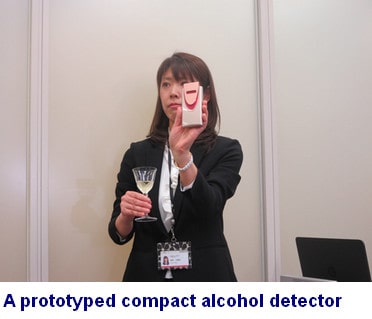Hitachi Ltd and Honda R&D Co Ltd announced March 24, 2016, that they have prototyped a compact alcohol detector to be used with a smart key.
When the alcohol detector finds that the driver is under the influence of alcohol, it makes it impossible to start up the engine. The two companies consider that the detector will contribute to preventing accidents caused by drunk driving.

The prototyped alcohol detector is equipped with a sensor that detects saturated vapor included in human breath (saturated vapor sensor). The sensor has a structure in which an insulating ceramic is sandwiched between electrodes. When the driver blows on the detector, water vapor in the breath is adsorbed by the insulating ceramic, changing the current flowing between the electrodes. By using this phenomenon, the sensor can judge whether it is a human breath or not within a few seconds.
Hitachi and Honda R&D improved the sensitivity of the sensor by employing a fine comb-shaped electrode with a length of about 5mm and shortening inter-electrode gap to 20-30μm. Though the new sensor does not require a mouthpiece on which the driver blows, its sensitivity is 10 times higher than that of conventional alcohol sensors using a mouthpiece. Also, the size of the new sensor is 1/50 that of sensors for conventional automotive alcohol detectors.
To judge whether the driver is under the influence of alcohol or not, Hitachi and Honda R&D employed three semiconductor gas sensors that measure the densities of ethanol, acetaldehyde and hydrogen, respectively. By including acetaldehyde and hydrogen, which are contained in the breath of a drunken person as metabolites, the measurement accuracy for ethanol was improved.
In Japan, when the amount of ethanol in 1L of breath exceeds 0.15mg, it is considered as being under the influence of alcohol. The prototyped alcohol detector can measure even an ethanol density that is 1/10 of the threshold within three seconds. Also, compared with the case where only ethanol is measured, the measurement accuracy was improved by about 200%, the companies said.
Furthermore, the new alcohol detector functions in conjunction with an automotive smart key. When the detector is placed on, for example, the center console of a car, it shows measurement results on an automotive screen and reads them out. If the detector finds that the driver is under the influence of alcohol, the engine won"t start.
No comments:
Post a Comment